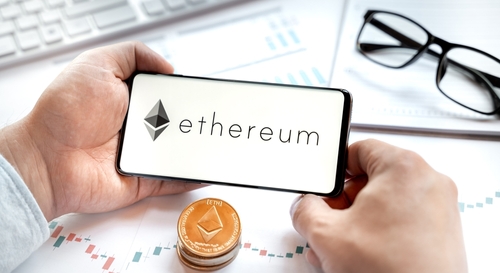ALBAWABA- Ethereum has grown in popularity as an investment choice, with ETH being one of the most extensively used and trusted cryptocurrencies in the world.
To help beginners navigate the process of buying and staking Ethereum, we asked crypto expert and staker Ahmad AlAli to guide newcomers through the process of purchasing and staking Ether. Here's his expert advice, broken down into simple steps.
Step 1: Understand Ethereum and its potential
Before investing in Ethereum, it's critical to understand what it is and how it operates. Ether is a blockchain platform that allows developers to create decentralized applications. Unlike Bitcoin, which is primarily a money, Ethereum is a decentralized platform that enables the development of smart contracts and decentralized applications (dApps). Ethereum's distinct feature makes it a valuable asset for investors.

Source: Shutterstock
According to Ahmad AlAli, "Investing in Ether is not just about buying a digital asset; it's about investing in the future of blockchain technology. Ether is a unique cryptocurrency with a wide range of applications, and its value will only increase in the coming years."
Step 2: Choose a reputable cryptocurrency exchange
When selecting a cryptocurrency exchange, it is critical to find a recognized platform that is secure and reliable. Before choosing an exchange, Ahmad AlAli encourages newcomers to conduct research.
"Security is critical when it comes to investing in cryptocurrencies," he explains. "You want to make sure you're using a trustworthy exchange that has a strong track record of protecting its users' assets."
Some popular cryptocurrency exchanges to consider include CoinMENA, Coinbase, Kraken, and Gemini.
Step 3: Create an account and verify your identity
Once you have chosen an exchange, you will need to create an account and verify your identity. This step is necessary to comply with anti-money laundering (AML) and know-your-customer (KYC) regulations.
"KYC and AML regulations help to ensure that cryptocurrencies are not being used for illegal activities such as money laundering," Ahmad AlAli explains. "While it may seem like a hassle to verify your identity, it's a necessary step to ensure the legitimacy of the cryptocurrency industry."
Step 4: Add funds to your exchange account
To buy Ether, you will need to add funds to your exchange account. Most exchanges allow you to fund your account using a bank transfer, debit or credit card, or cryptocurrency.
According to Ahmad AlAli, "It's important to choose a funding option that works best for you. Bank transfers are typically the cheapest option, but they can take several days to process. Debit and credit card purchases are usually instant, but they come with higher fees."
Step 5: Buy Ethereum
Once you have added funds to your account, you can buy ETH. On most exchanges, you can buy Ether by navigating to the Ethereum trading pair, entering the amount you want to buy, and clicking the buy button.
"When buying Ether, it's important to consider the price fluctuations and timing your purchase accordingly," Ahmad AlAli advises. "It's a good idea to keep an eye on the market and wait for the price to drop before buying."
Step 6: Transfer Ethereum to a secure wallet
After buying Ether, you should transfer it to a secure wallet. A cryptocurrency wallet is a software application that allows you to store, send, and receive cryptocurrencies.
"Security is of the utmost importance when it comes to storing your Ether," Ahmad AlAli warns. "Make sure to use a reputable wallet and never share your private keys with anyone."
There are several types of wallets, including desktop wallets, mobile wallets, and hardware wallets. Desktop and mobile wallets are usually free, while hardware wallets have a price tag. Hardware wallets are the most secure option as they store your cryptocurrency offline.
Step 7: Stake Ethereum
Staking Ether is a process of validating transactions on the Ether network and contributing to the security and decentralization of the blockchain. In return for staking, users earn rewards in the form of additional Ether.
To stake Ethereum, you will need to choose a staking platform or a staking pool. A staking platform or pool is a service that allows users to stake their Ether without having to run their own node. Ahmad AlAli recommends doing thorough research to select a reputable and reliable staking platform.
"When staking Ether, it's important to understand the risks and rewards associated with the process," Ahmad AlAli advises. "Make sure to carefully review the terms and conditions of the staking platform, including the fees, lock-up periods, and potential risks."
Once you have chosen a staking platform, you will need to follow their instructions to stake your Ether. This may involve transferring your Ether from your wallet to the staking platform, setting up a validator node, and configuring your staking preferences.
Step 8: Monitor your staked Ethereum and manage rewards
After staking your Ether, it's important to monitor your staked Ethereum and manage your rewards. Most staking platforms provide a dashboard or interface that allows you to track your staking activity, including the amount of Ethereum staked, the rewards earned, and any penalties incurred.
Ahmad AlAli recommends regularly checking your staking activity and keeping an eye on any updates or changes in the staking platform's terms and conditions. It's also important to manage your rewards effectively, whether by reinvesting them, withdrawing them, or using them for other purposes.
Step 9: Stay informed and stay secure
As with any investment, it's crucial to stay informed about the latest developments in the cryptocurrency market and Ethereum ecosystem. Stay up-to-date with news, trends, and changes in regulations that may impact your investment.
Ahmad AlAli advises, "Educate yourself about the risks and rewards of investing in Ethereum and make informed decisions based on your own research and risk tolerance. Be cautious of scams, phishing attempts, and fraudulent schemes that may target cryptocurrency investors. Always prioritize security by using reputable exchanges, wallets, and staking platforms, and implementing strong security measures such as two-factor authentication and unique, complex passwords."
In conclusion, buying and staking Ethereum can be a rewarding investment opportunity for beginners. By following this step-by-step guide and taking the advice of cryptocurrency expert Ahmad AlAli, beginners can navigate the process with confidence. Remember to understand Ethereum and its potential, choose a reputable exchange, verify your identity, add funds to your account, buy Ethereum, transfer it to a secure wallet, stake Ethereum, monitor your staked Ethereum, stay informed, and stay secure.







